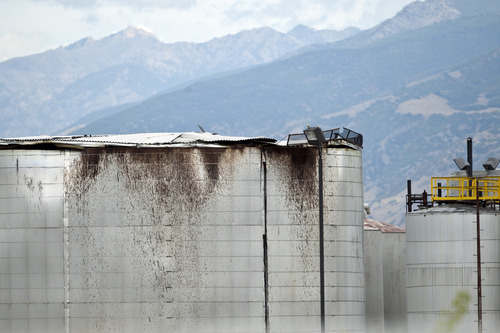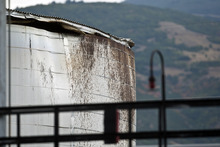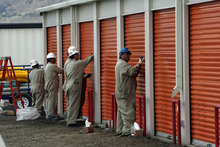This is an archived article that was published on sltrib.com in 2012, and information in the article may be outdated. It is provided only for personal research purposes and may not be reprinted.
Woods Cross • Scores of southern Davis County residents no doubt were surprised the morning of Sept. 1 to find spatters of thick, sticky oil on their homes, cars, lawns and gardens after a storage tank blew at a nearby refinery.
Maybe they shouldn't have been. Records show that a leak, spill, fire, blast or air-pollution violation occurs, on average, every nine days at the five refineries bordering Salt Lake and Davis counties — though most of those incidents aren't so vast, visible or menacing.
The tank explosion, according to state records, was one of more than 150 environmental incidents at the Wood Cross refinery since mid-2003, when HollyFrontier took it over from Phillips 66. The plant accounted for nearly 40 percent of the 519 environmental incidents linked to the five Utah refineries since 2000.
Reports to the state Department of Environmental Quality (DEQ) reveal refinery incidents vary widely in severity, ranging from hundreds of short-lived releases of unauthorized pollution from smokestacks to at least four other major explosions, including two in 2009 at the Silver Eagle refinery, which injured workers and damaged nearby homes.
Based on DEQ records dating to 1990, by far the most frequent event involved equipment failures leading to sulfur-based compounds — usually toxic sulfur dioxide, stinky hydrogen sulfide or corrosive sulfuric acid — being released through refinery stacks or spilled onto the ground. In hundreds of cases during that 22-year period, records show, such releases stemmed from malfunctions in the plants' sulfur-recovery units or from power outages.
—
Reports indicate fires broke out in at least 17 incidents between 1992 and 2009. And at least 89 refinery accidents since 2000 led to spills or leaks, according to DEQ records.
Gasoline, diesel, refining sludge, jet fuel, wastewater and refining chemicals were the most common substances spilled, though refinery officials note that all but a few of the spills were contained within plant perimeters. Spill accidents often were attributed to faulty pipes or tanks or to mishaps during the transfer of volatile liquids from transport trucks.
Taken together, the safety record is putting additional scrutiny on recent proposals from three of the refineries to expand or upgrade their operations in hopes of capturing a share of an oil boom under way in eastern Utah and meeting demand for refining a new distinctive crude oil known as black wax.
"No time is a good time to have a safety incident like this at one of Utah's refineries," said Lee Peacock, president of the Utah Petroleum Association. "Holly is going to do everything in its power to make sure it doesn't happen again."
Peacock and company officials insist they maintain robust risk-monitoring and accident-prevention programs, giving them strong and, in some cases, award-winning safety records in light of the heavy industrial nature of what they do.
Yet accident records and other evidence underscore the risks inherent to urban centers located in proximity to these refineries, some of which began operating more than 100 years ago, well in advance of the residential presence that now surrounds their borders.
"I just don't think that refineries and densely populated areas are compatible," said Linda Johnson, who monitors environmental issues for the Utah League of Women Voters.
Brian Moench is an anesthesiologist and co-founder of Utah Physicians for a Healthy Environment, a group focused on potential health impacts of the refineries' air emissions and chemical stockpiles. Active at a series of public hearings on the proposed refinery expansions, the group is considering legal action to stop the projects.
Of particular concern, Moench said, are reserves of hydrofluoric acid kept at three of the refineries. By the oil processors' own estimates, he notes, an explosive release of the inorganic acid could threaten hundreds of thousands of Wasatch Front residents.
"I just don't see how it can be considered an acceptable risk to the community for them to continue to use it," Moench said. "It just seems to be a head-in-the-sand approach."
—
DEQ has records on at least four other refinery explosions: at the Chevron facility in Salt Lake City in 1992; at Flying J in North Salt Lake, now run by Big West Oil, in 1994; and two blasts in 2009 at Silver Eagle in Woods Cross.
In January 2009, a fuel tank at Silver Eagle blew up, sending four workers to the hospital with severe burns and forcing evacuation of nearby homes. Firefighters narrowly prevented the blaze from spreading to other fuel tanks nearby.
The second explosion, in November, grew from a faulty hydrogen and diesel fuel line, shooting flames into the air and shock waves as far away as Farmington and Layton.
Although nobody was injured, the blast damaged about a dozen homes severely and at least 300 residents filed claims against the company. One Woods Cross couple won a $325,000 jury award for economic and emotional damages.
Whatever its cause, the recent Holly tank eruption spewed oil as far as a mile, across portions of Woods Cross, Bountiful and West Bountiful. The refinery mounted a swift response, according to neighbors and state officials, and crews will be pressure-washing homes and repairing lawns for several weeks.
The tank held a thick fuel oil otherwise solid at room temperature. The 1.2 million-gallon tank and others like it at the refinery are fitted with steam-heated coils to liquefy the contents by keeping them between 200 and 300 degrees, said Holly Environmental Manager Mike Astin.
Officials are exploring the possibility that water seeped into the tank and vaporized, elevating the pressure inside and eventually bursting a seam around the roof while sending more than 8,000 gallons of oil skyward.
The steam coils are one possible source of the water, Astin said, but it "could have come from a number of other sources."
Holly and state regulators say it will take weeks to fully investigate the incident, the fourth that the refinery has reported this year. The previous three involved equipment failures in the venting of air-borne pollutants.
—
The tank explosion also came amid fresh memories of the June 2010 Chevron pipeline leak that scarred Red Butte Creek, Liberty Park's pond and parts of the Jordan River. That spill, along with another from the same pipeline six months later, appears to have heightened the sensitivity of regulators and public officials to the importance of an effective response.
"We learned from that to assess the impact quickly, take care of the problem and affix blame at a later appropriate time," said Bryce Bird, director of the state Division of Air Quality, which is investigating the Wood Cross refinery incident and has a say in the proposed refinery expansions.
The Holly, Chevron and Tesoro refineries all plan major capacity upgrades to accommodate the record amounts of black- and yellow-wax crude reserves coming from Utah's Uinta Basin. The three hope to invest as much as $488 million to pump up daily capacity by more than 34,000 barrels and add hundreds of well-paying jobs.
Akin to petroleum jelly, these new reserves of waxy crude also solidify unless kept warm, requiring heat for extraction and storage. The product also must be shipped in insulated oil tankers, mostly along U.S. Highway 40, to the Salt Lake Valley.
—
While state officials are reviewing project applications from Holly and Tesoro, their jurisdiction is limited to seeing whether new equipment complies with air-emission standards for federally regulated pollutants such as sulfur dioxide, nitrous oxide and particulate matter. From an air-quality perspective, regulators believe the proposed shift to refining low-sulfur black wax will lower polluting emissions while also bringing new and more efficient refining technology online.
But as for a safety review of refinery construction plans, Bird said, "It's not us."
Industry safety is a perennial concern, locally and nationally.
A month ago, a Chevron plant in Richmond, Calif., caught fire and thick smoke sent more than 15,000 people to emergency rooms with respiratory problems and eye, nose and throat irritations. The U.S. Chemical Safety Board is investigating.
At one point in 2010, the same board was conducting seven separate investigations of oil refinery accidents simultaneously, a pattern board Chairman John Bresland at the time called "a significant and disturbing trend that the refining industry needs to address immediately."
Two years after a March 2005 explosion at a Texas City, Texas, refinery killed 15 workers and injured 170, the federal Occupation Safety and Health Administration launched a program mandating inspections of all U.S. refineries within two years.
Under an agreement with the U.S. Labor Department, Utah is one of several states operating its own worker-safety and health-enforcement program, known as UOSH. To date, federal records indicate UOSH compliance officers have conducted the federally mandated in-depth inspections at three of Utah's urban refineries: Holly, Silver Eagle and Big West Oil. They've done partial inspections at the other two: Chevron and Tesoro.
—
No deaths have been reported in Utah's oil refining industry going back to 2001, according to federal records. The lone major-injury accident in the same time period was the January 2009 explosion at Silver Eagle.
Overall injury rates for refinery workers, both nationally and in Utah, are substantially below similar rates for manufacturing and private-industry workers as a whole, the U.S. Bureau of Labor Statistics reports.
Utah refineries require their workers to be certified in safety practices before they can go on-site.
Still, a federal audit in late 2009 said UOSH had cited refineries for a total of 16 willful, one repeat and 787 serious violations of federal worker-safety rules, under the stepped-up inspection program. Those citations drew more than $1 million in fines. Most of that sum was levied in connection with the Silver Eagle explosions.
Refinery inspections "are very, very labor intensive," said Eldon Tryon, compliance manager with UOSH. "You can be assured we do our best."
But with only 20 compliance inspectors covering all of Utah— six of whom are trained in process safety management for refineries — UOSH is forced to direct its resources toward industries with the highest rates of worker injury and fatalities, Tryon said. In recent years, that has meant heightened scrutiny for sectors such as manufacturing and residential construction, instead of oil refining.
"If you look at the refineries' record," Tryon said, "they're not the worst actors, so to speak."











